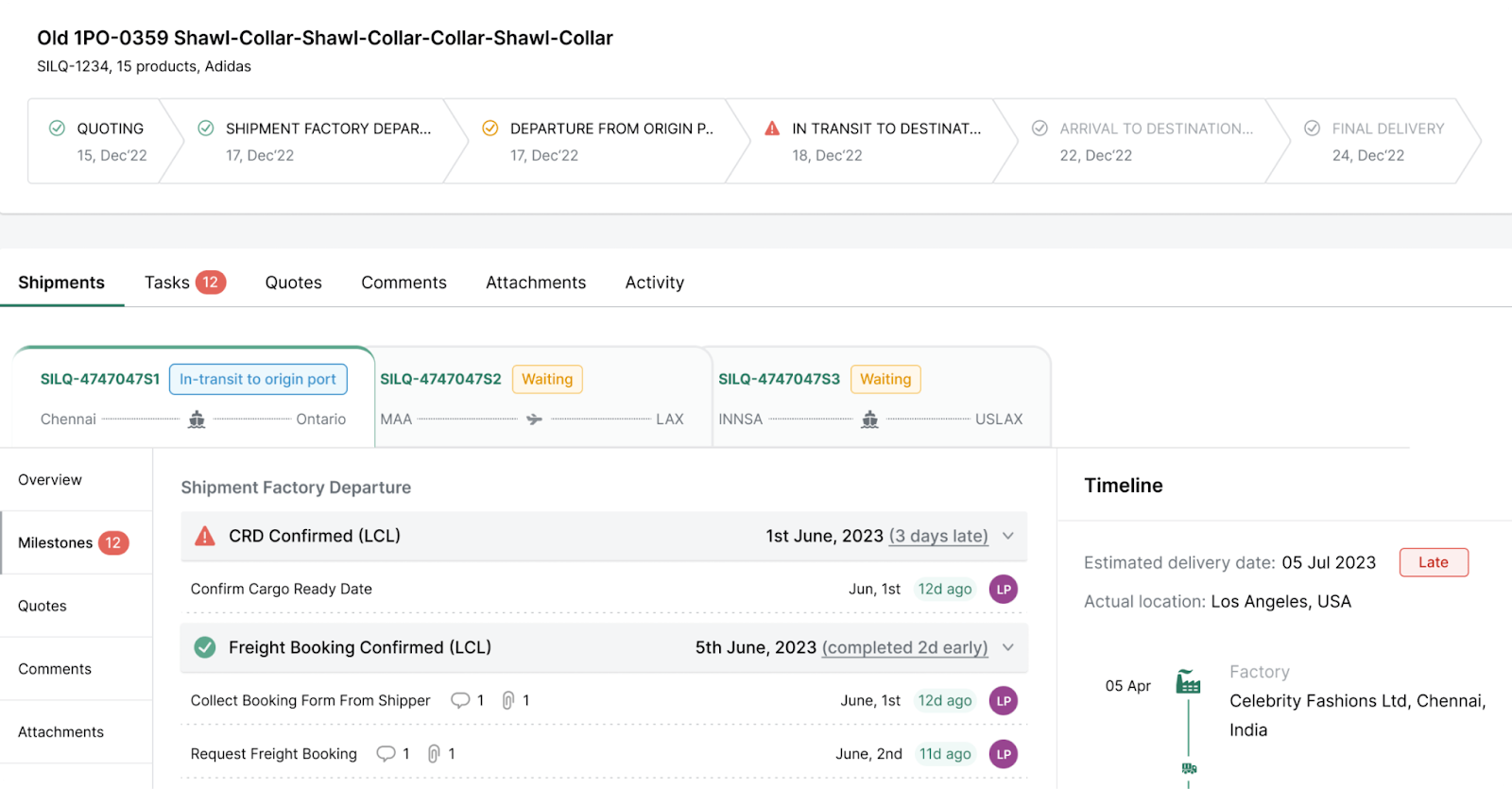Enhancing Decision-Making and Visibility: The Role of Real-Time Data in Supply Chain Management

Supply chain success is measured in seconds, not days, in this fast-moving, high-expectation market. When your customer expects flawless delivery of a $3,000 handbag or a custom-built home audio system, a missed handoff in your supply chain isn't just a delay but a brand risk.
And yet, too many logistics operations still rely on after-the-fact reporting and fragmented communication. The fix? Real-time data.
Solutions like Silq are helping brands unify inspections, freight, and customs updates into one platform, thereby minimizing blind spots and maximizing control. Whether you're tracking raw materials from a factory in Vietnam or watching a shipment clear U.S. customs, real-time visibility gives your team the power to act, not react.
Let’s explore how real-time data, combined with technology, is transforming supply chain management for companies that move fast, ship globally, and meet customer expectations.
Why Real-Time Supply Chain Visibility Is the New Standard for Global Brands
Traditional supply chains run on historical data. But what worked yesterday doesn’t always solve today’s problems, especially when your stock is stuck at port, raw materials are delayed, or customer demands shift overnight.
The challenges of traditional supply chain management are listed below:
- Limited Visibility: Without real-time insights, companies have to respond to disruptions reactively rather than being able to plan ahead.
- Slow Decision-Making: Decisions based on outdated information from legacy systems are slow and susceptible to errors. This can lead to lower sales, decreased customer satisfaction, and diminished competitive edge.
- Inflexibility: Traditional supply chains cannot adapt quickly enough to changing market conditions, supply disruptions, or sudden shifts in demand. Inflexibility can have serious repercussions for a company's ability to meet customer demands efficiently.
Real-time supply chain visibility gives you immediate insights into your operations so you can:
- Spot bottlenecks before they snowball
- Optimize delivery routes or reroute in-transit shipments
- Manage stock levels with precision
- Detect and react to supply chain disruptions as they unfold
- Reduce the need for estimates and assumptions
How Silq Enhances End-to-End Supply Chain Visibility
In the realm of high-end goods, where precision and reliability are paramount, Silq stands out by offering on-the-ground oversight coupled with an intuitive platform that provides unparalleled visibility at every stage of the supply chain.
- Unified Platform for Comprehensive Visibility
Silq consolidates critical supply chain functions, from inspections to shipping, into a user-friendly platform. This allows stakeholders to access real-time data on production statuses and delivery timelines, facilitating informed decision-making and proactive issue resolution.

- Real-Time Tracking & Predictive Insights
With Silq's advanced tracking capabilities, businesses gain real-time insights into the locations and conditions of their shipments. This visibility helps analyze historical data to forecast potential delays and plan proactively.
- Customizable Workflows
Silq offers customizable workflows that align with specific operational needs and boost supply chain performance. Features like task templates and integrated communication tools help teams stay synchronized, reducing errors and enhancing efficiency.

- Enhanced Collaboration & Transparency
Silq fosters collaboration by providing all stakeholders with access to real-time information. This transparency ensures that everyone is on the same page, reducing misunderstandings and facilitating swift responses to any issues that may arise.
Key Benefits of Implementing Real-Time Visibility
1. Smarter Decision-Making Through Live Data
Every hour counts in premium logistics. With real-time insights, you're not making choices based on last week's numbers, you’re reacting to what’s happening now.
- Use analytics tools to track delivery times, inventory turnover, and freight exceptions
- Empower teams with actionable insights from integrated dashboards
- Make data-driven decisions across procurement, warehousing, and distribution
Tools like Silq surface exceptions, ETA delays, market trends, and inspection milestones, helping teams move from reactive firefighting to proactive planning.
Read More: Revolutionizing Retail Logistics: How the Silq Platform Enhances Supply Chain Efficiency
2. Enhanced Inventory Management & Demand Forecasting
Striking the right balance between stockouts and overstocking is tough, especially when lead times fluctuate and high-margin goods are involved.
With real-time analytics and advanced forecasting algorithms, you can:
- Monitor inventory levels dynamically
- Adjust buffer stock using predictive analytics
- Improve inventory management with alerts based on order volume and SKU velocity
- Leverage in-app inspection updates to forecast delivery readiness and adjust stock availability.
Read More: Why Ordering Small & Frequent Shipments Benefits Businesses
3. Boosting Customer Satisfaction and Retention
When you’re selling high-end products, customer experience is everything. Missed ETAs or vague updates can chip away at your brand.
Real-time visibility gives your teams and customers:
- Accurate, real-time shipment tracking
- Transparency into delivery times and delays
- Faster resolution of order exceptions
How Real-Time Data Flows Through Modern Supply Chains
The key challenge to utilizing real-time data is getting it into a form that is both comprehensive and actionable. After all, a business could be awash in data streams and no further ahead if it doesn’t know what to do with them. Here’s how real-time data is collected and utilized by leading ecommerce companies to boost their supply chain efficiency.
Ground-Level Visibility: Real-Time Factory Inspections
Real-time supply chain visibility doesn’t just rely on technology. Effective supply chain management also includes human elements to deliver real-time insights from inspection teams on the ground.
Silq’s on-site inspectors use mobile tools to report product quality, packaging compliance, and completion status in real-time. This data feeds directly into your dashboard, ensuring you're never blindsided.
Combining local knowledge with technology allows businesses to manage risks effectively while upholding high standards of quality service provision in their supply chain operations.
Connecting the Dots with IoT and Automation
The Internet of Things (IoT) powers a new generation of data collection. From IoT devices on cargo to warehouse sensors and factory equipment, each touchpoint generates real-time supply chain data.
- Automation reduces manual reporting
- Smart tags and GPS improve asset tracking
- Temperature and vibration sensors monitor sensitive shipments
Platforms like Silq tap into IoT and factory data to provide real-time visibility from production line to port—helping you spot delays before they impact your downstream processes.
Breaking Silos with Centralized Systems
A significant development in supply chain technology has been the emergence of platforms that integrate various functions into a single, cohesive system. This provides an all-in-one view of inventory, supply network, orders, logistics, and customer feedback, as well as data from multiple sources, enabling more informed decision-making.
Gone are the days of juggling spreadsheets and siloed reports. Today, visibility means data integration across systems like:
- ERP platforms for procurement and finance
- TMS for transportation tracking
- WMS for warehousing
- Inspection tools for quality assurance
The goal? A unified view of your supply chain processes, where every stakeholder, from sourcing to CX, works off the same live data. Solutions like Silq offer this integration out of the box—connecting freight bookings, customs updates, and inspection reports into a single source of truth.
Addressing the Challenges of Implementation
Implementing real-time visibility across your supply chain can be complex. Common hurdles include:
- Fragmented systems and poor data integration
- Limited internal capabilities for advanced analytics
- Supplier resistance or lack of automation
The fix? Start with your most delay-prone lane or product line. Use a pilot program to prove ROI, reduce inefficiencies, and gain buy-in. Expand from there without overhauling your full tech stack upfront.
Choosing the Right Visibility Partner
When choosing a visibility solution provider, look for:
✅ End-to-end tracking from raw materials to final delivery
✅ Artificial intelligence for predictive analytics and optimization
✅ Cost savings from reduced manual tasks and better planning
✅ User-friendly dashboards with configurable metrics
✅ Easy integration with existing platforms (e.g., ERP, WMS, inspection systems)
For brands seeking a practical, end-to-end approach to visibility, without piecing together multiple systems, Silq offers an integrated suite covering inspections, freight bookings, customs management, and real-time tracking.
Final Thoughts: The Future Is Data-Driven and Live
To meet today’s customer demands, modern logistics teams need more than agility—they need foresight. That’s only possible when you combine real-time data, machine learning, and scalable analytics tools.
By embracing real-time visibility, you’ll not only reduce risk and improve supply chain efficiency, but gain the kind of competitive edge that sets your brand apart—especially in a world where precision, trust, and speed define success.
Want to turn your supply chain into a proactive, data-driven engine?
Explore how Silq helps premium brands orchestrate every stage—from factory inspections to shared container shipping to customs clearance. Experience real-time supply chain control without the complexity.
Ready for Supply Chain Predictability?
Importers using Silq ship smarter, safer, and with total control.







